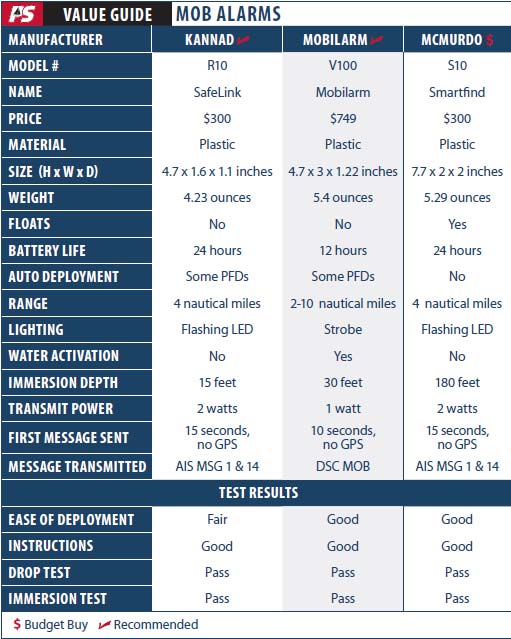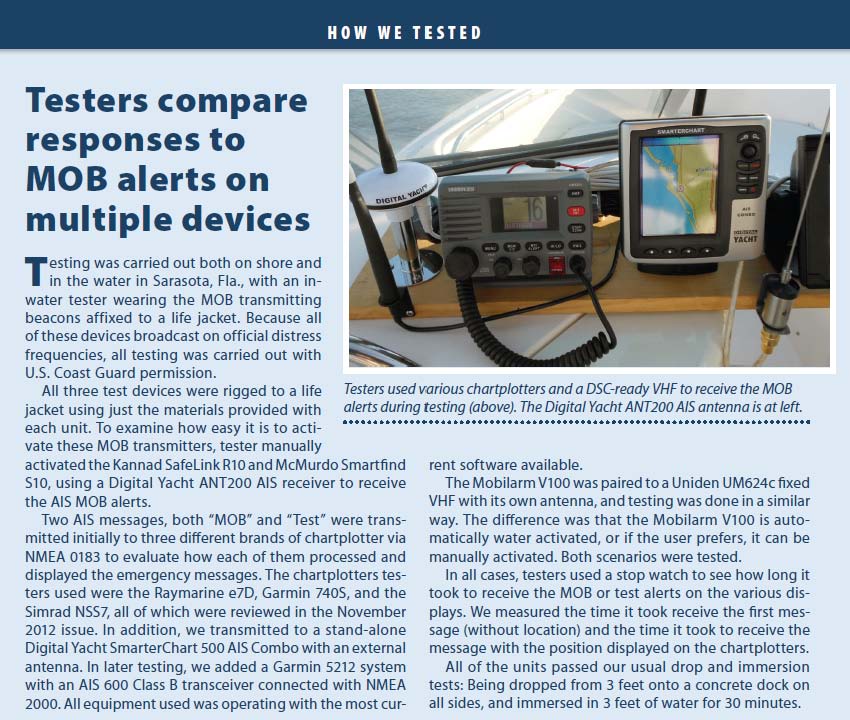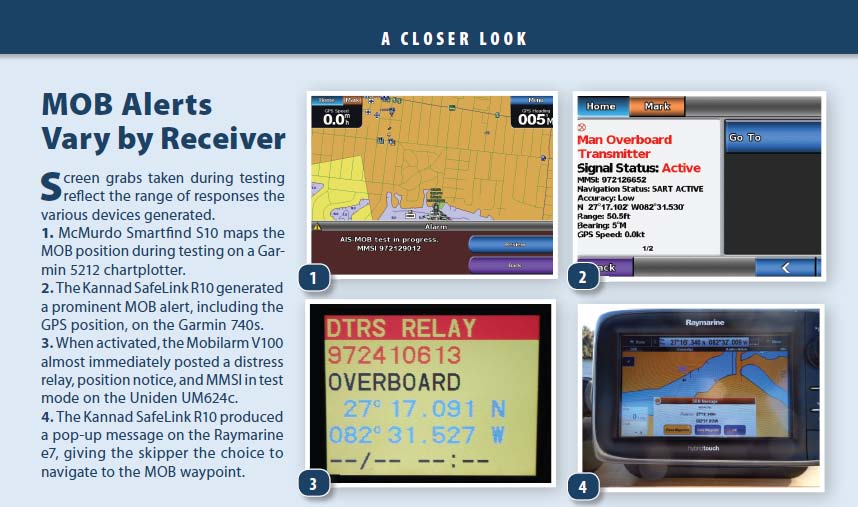
Weve been following man-overboard beacons, flags, and lights for more than 30 years now-the most recent report (PS, April 2011) compared two electronic devices that allowed users to self-rescue overboard crew members. In our testing, weve found that a major shortcoming of many electronic man-overboard (MOB) transmitters is their inability to track the person in the water (PS, May 2008).
Most of the more-modestly priced MOB beacons weve reviewed simply alert the crew that someone has fallen overboard. Finding them is another story. Adding the ability to track a person in the water meant shelling out $2,000 or more.
But in the past two years, with the integration of the Automated Identification System (AIS) and Digital Selective Calling (DSC) into man-overboard tracking, MOB-recovery technology has changed dramatically. Although international oil-rig workers have been using similar devices for years, bringing them to the recreational marine market was slow. Its been a little over a year since the first generation of AIS and DSC MOB alarms was approved for recreational use.
For more, important insight into this topic, subscribers can read Practical Sailors related articles: MOB gear and tactics in the November 2005 and January 2006 issues; and throwable rescue devices in the May 2006 and April 2007 issues. These, along with other key safety reports, are also included in our e-book, MOB Retrieval and Techniques, available at PSs online bookstore at www.practical-sailor.com.

What We Tested
For this comparison, we compared the Kannad SafeLink R10, McMurdo Smartfind S10, and the Crewsafe Mobilarm V100, portable transmitters that can be attached to a life jacket. Both the Kannad and McMurdo brands were acquired in 2009 by the French-based Orolia Group, a high-tech company that is carving out a niche in the marine safety market. The Crewsafe Mobilarm V100 is manufactured by Marine Rescue Technologies (MRT) in Perth, Australia. MRT, also the maker of the Sea Marshall MOB retrieval system, acquired Mobilarm in 2011. The rash of business deals that preceded the official approval of these systems suggests that there is a lot of excitement about the future market potential for this equipment. One new piece of gear that we didnt include in this report but is related to the group is Garmins new Quatix sailing watch. Among its numerous capabilities and features is an MOB alarm that sounds when the wearer falls overboard. We will be reporting on it in an upcoming article.

The Technology
Both the Kannad R10 SafeLink and the McMurdo Smartfind S10 send MOB messages to an AIS receiver. The AIS safety-related message is transmitted either as a test message to verify operation or as an active MOB message. Both the SafeLink and Smartfind use transmit identification numbers to identify the device, and the alerts can be received by ships within their transmitting range that are equipped with AIS receivers. Unlike an Emergency Position Indicating Radio Beacon (EPIRB) or Personal Locator Beacon (PLB), these units do not alert via satellite.
To receive the MOB alerts from the Kannad or McMurdo, a boat will need to have an AIS receiver-either a standalone device, or one that is integrated with a chartplotter or onboard computer. When the transmitter is activated, either as a test message or active MOB alert, the message transmit time and how it is displayed depend on the receiver and data processor (computer, chartplotter, etc.) being used. All MOB units we tested had a built-in delay of 10 or 15 seconds to prevent accidental activation. In general, when you activate the MOB devices, there is a short, pre-programmed delay, then the MOB message is sent without the position. When the transmitter acquires a GPS fix, usually within two minutes in our test, the MOB message is sent again with the position added. The position data is updated and re-transmitted every minute.
The Mobilarm V100 operates very similarly to the R10 and S10 units, except it sends the MOB alert and position data using the Digital Selective Calling frequency, rather than AIS. To receive the Mobilarm alerts, users need only a DSC-equipped VHF radio onboard. All newer VHFs are DSC capable, and a fixed or handheld VHF is basic equipment that even small boats have on board.
Testers found that it took all three MOB devices about the same amount of time to broadcast alerts. The Kannad and McMurdo units took between 14 and 32 seconds to broadcast the first message, without position. The average time it took to receive an accurate position of the man overboard was about 1 minute and 30 seconds; the shortest delay was 1 minute, 16 seconds; the longest was 2 minutes, 36 seconds. Responses varied slightly among the chartplotters we used for testing, and these times are the averages for all of them. On first activation, the GPS receivers were performing a cold start, meaning they had no useful last position to reference when searching for GPS satellites. Afterward, acquiring a GPS fix was a little quicker. The Mobilarm V100 DSC message times were nearly identical. (For details on the test protocol, see the accompanying How We Tested.)
A fast MOB response time is critical. To provide some prospective, a sailboat traveling at 6 knots will travel approximately 900 feet before receiving the first MOB position fix. A boat traveling at 20 knots will be 3,000 feet away. This does not include the time it takes to manually activate the unit, which can add precious seconds to the clock.
In our view, it is important that any MOB alarm alert the crew as soon as possible, whether a fix is available or not. In a perfect world, the fix would be almost instantaneous.
Kannad R10 SafeLink
The Kannad R10 SafeLink was the most compact of all the units we tested. It is designed to be manually activated, or can automatically activate upon inflation of specific brands of life jackets. These inflatable life jackets are manufactured by Ocean Safety, Kadematic, Spinlock, and Baltic. In all cases for automatic activation, the SafeLink must be installed by the life jacket manufacturer or its authorized service centers. Practical Sailor did not test this capability.
The SafeLink comes with a padded case equipped with a clip and a back loop that can be threaded onto to a life jackets strap. The SafeLink also has a 3-foot lanyard to secure the device to a life jacket or person. The unit does not float and must be tethered to the life jacket or user.
To activate the Kannad SafeLink, you must pull a plastic tab on a lanyard away from the unit and then pull the orange plastic antenna cover off of the unit, also using its lanyard. When the cover is removed, a flat metal antenna springs out, and the unit starts to transmit and flash its LED light.
To test the SafeLink, users must pull the plastic tab away from the unit with a short lanyard. This exposes the black test button. Pressing this button for one second initiates a system test, and LEDs indicate battery life. Pressing the test button for 10 seconds verifies that a position fix has been acquired, and an AIS test message is sent. The LEDs show the status, but in an actual emergency or in bright light, discerning the LED lights and determining what they mean will be difficult.
The manufacturer can set up the SafeLink for automatic activation so that it will still function in the case of an unconscious victim. However, the unit must remain out of the water in order to transmit, so it should be attached to the life jacket at the highest point possible.
Bottom line: The R10 worked as designed, but deploying it required two hands and more effort than we expected; and the instructions were not as clear as they could be, in our opinion. The Kannad SafeLink R10 has the potential to be automatically or semi-automatically activated, if professionally fitted to specified life jackets. This is our Recommended choice for sailors who want automated deployment and integration with a chartplotter or AIS receiver.
McMurdo S10 Smartfind
The cylindrical McMurdo S10 Smartfind is a manually activated unit, and its the only one we tested that floats. It comes with a padded case with a sewn loop, 1.5-inch-wide Velcro webbing straps for attachment, and a 6-inch adjustable wrist lanyard. The Velcro straps also can serve as a headband to attach the Smartfind to the users head, keeping it high and hands free.
Activation of the Smartfind is simple: Pull the red tab at the bottom of the unit, and a cotter pin pulls out. Pull the orange base out about one-eighth of an inch, and twist it clockwise. The units LED will then start to flash, indicating operation, and the alert will transmit.
The McMurdo has two test modes. The short test indicates battery condition, and the long test sends an AIS test message and verifies GPS operation. To perform the short test, rotate the base counter-clockwise to its stop and release. After 5 seconds, the unit will flash; the number of flashes indicates battery strength. To perform the long test, rotate the base counterclockwise to its stop, and hold it there for 10 seconds.
To ensure maximum range, the manual instructs the person in the water to hold the S10 Smartfind over his or her head. This means you need to remove it from its padded case and attach the lanyard to your wrist. For hands-free transmitting, you can attach the unit to your head using the two Velcro straps as a headband.
Bottom line: The McMurdo Smartfind S10 was very easy to deploy and operated as designed. It was the only unit that floated, and had clear operator instructions. Priced much less than the Mobilarm and the same as the SafeLink, it is the PS Budget Buy.
Mobilarm V100
The Mobilarm V100 was the most sophisticated and expensive of the devices PS tested. It comes with a plastic clip that can be attached to a life jacket, and an 18-inch lanyard. Like the Kannad unit, the V100 can be professionally fitted onto a wide variety of life jackets. The V100 also has some optional accessories, such as a longer antenna and an extension wire for the built-in water sensor, to ensure that it activates even if the person in the water is unconscious. When equipped with a longer antenna, the unit is supposed to have a range of about 10 miles, compared to the four-mile range for the other two units.
Activation of the V100 is either by water sensing or manually sliding a large button to the on position. For units that are fitted to a life jacket, there is a snap-on safety cover that sets the activation button in ready and prevents inadvertently turning the unit off. To manually activate, the user slides the button to on and releases the end of the whip antenna. The strobe light starts to flash when activated. For water activation, the switch must be in the ready position, and the unit must be immersed for 5 seconds.
The V100 has an extensive self-test routine with an authoritative digital voice that guides you through the process, declares the status of various tests-MMSI identification, battery life, water sensing, GPS fix, strobe operation-and sends a VHF DSC test message. Short tests can be performed on any of the six functions by following a voice prompt menu system, or a full system test can be run by default. During testing, the test message is sent to the VHF radio, and the strobe light flashes.
Bottom line: The Mobilarm V100 was easy to activate, and if professionally fitted to a life jacket, it requires no action by the user to activate it in the water. Although it was the most expensive of the units tested, it does not require a chartplotter or AIS receiver, only a DSC-capable VHF radio, which most boats already have. It has test capabilities that allow all of its features to be individually tested, the brightest strobe light, and the most comprehensive set of user instructions. This is our Recommended choice for small boats and others that do not have a chartplotter, those who want automatic activation, and those who prefer the DSC interface.
Conclusions
AIS and DSC MOB technology is relatively new, and the effective performance of these units depends on the AIS or VHF receiver, an NMEA interface, and chartplotter. Older chartplotters, or even newer units with older software, may not respond as desired to AIS MOB alerts. Instead of receiving an AIS safety message that will generate a warning on the chartplotter, the device could show up as just an AIS target, with no warning message, audible or otherwise.
Interfacing the AIS data to your chartplotter must be carried out correctly, and how the AIS messages are displayed is dependent on the chartplotter manufacturers software. The Raymarine e7D performed perfectly in all tests, providing both a prominent visual MOB message and an audible alert.
The Garmin units worked perfectly on the first deployment of each device, displaying a banner message across the screen and an audible alert. But on subsequent deployments of the AIS units, the banner did not appear, even though the AIS MOB target did. We later discovered that this was a software issue, which required that previous MOB alerts be cleared before subsequent ones can properly displayed.
Our main disappointment was the Simrad NSS7. Despite several calls to tech support, we could not get the Simrad NSS7 to acknowledge the MOB messages at all. We are still researching the reasons for this.
Another lesson learned was that the users of these devices must practice deploying and activating them. Deployment should be instinctive, and depending on vessel speed, quick activation could be critical. Getting the best range out of these devices requires following the manufacturers recommendations. The AIS receiver, VHF radio, and chartplotter systems need to be thoroughly tested, and the system behavior and warnings clearly understood before relying on them.
Finally, as effective as these devices are for self-rescue, we would not consider them to be a substitute for a PLB or EPIRB, which deliver instant alerts via satellite to the Global Marine Distress and Safety System.




































